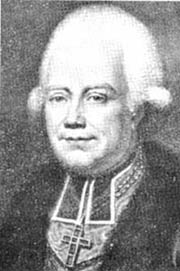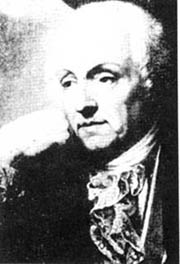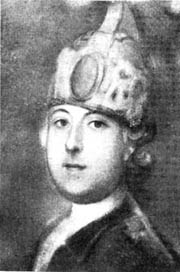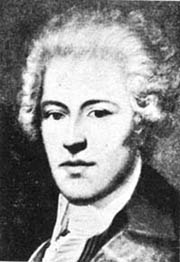Editors of this issue: Antanas Klimas, Thomas Remeikis, Bronius Vaskelis

|
LITUANUS
LITHUANIAN QUARTERLY JOURNAL OF ARTS AND SCIENCES
Volume 19, No.4 - Winter 1973
Editors of this issue: Antanas Klimas, Thomas Remeikis, Bronius Vaskelis Copyright © 1973 LITUANUS Foundation, Inc.
|

|
THE EDUCATIONAL COMMISSION OF POLAND AND LITHUANIA 1773-1794:
200th Anniversary of its Establishment
J. A. RAČKAUSKAS
Chicago State University

Ignacy Massalski |

Joachim Chreptouricz |

Adam Czartoryski ,General of the Podolian Territory | 
Ignacy Potocki, Secretary, Grand Duchy of Lithuania |
Introduction
1973 marks the 200th anniversary of the establishment of the Educational Commission of Poland and Lithuania. The 200 years since its establishment have seen many changes in educational theory and practice, but the basic ideals of the Educational Commission are still embodied in many of the modern school practices, not only in Poland and Lithuania but in other countries as well. The work of the Educational Commission reflected the thinking of Jean Jacques Rousseau, John Locke, and other leading educationalists of the 18th century. The influences of the Educational Commission on the Russian, American, Chilian, and Prussian educational systems is still under examination.
Establishment
The Commission for National Education of the Kingdom of Poland and the Grand Duchy of Lithuania was established 14 October 1773.1 By purpose and design it combined the educational systems of both Poland and Lithuania under one national controlling body, thus directly taking over the responsibility for education.
The establishment of the Educational Commission is a direct outgrowth of the dissolusionment of the Jesuit Order which was effected by Pope Clement IV in his bull Dominus ac Redemptor Noster issued on 21 July 1773.2 Since education in Poland and Lithuania was mainly in the hands of the Jesuits, the dissolution would have left the educational system in complete disorder. Lithuanian Vice-Chancellor Joachim Chreptowicz (1729-1812) and Bishop of Vilnius, Ignacy Ksiaze Massalski (1729 -1794) proposed to the Polish - Lithuanian Sejm that a special Educational Commission, responsible directly to the Sejm, be established to continue not only the work of the Jesuits, but to control all educational activity.
The Sejm accepted the proposal and appointed to the Educational Commission eight members with Bishop Massalski as chairman (1773 -1777) .3
Educational Reforms
The Educational Commission decided that all schools from the elementary level to the university must undergo basic reform. The Educational Commission began by issuing on November 22, 1773 its first Uniwersal (Ųniwersal Oglaszajacy Komisje Edukacyjna) which described the Educational Commission's aims and requested suggestions for educational reform. Within a short time eleven proposals were received, some of which were from members of the Educational Commission. On the basis of these proposals, the Educational Commission evolved a hierarchical and centralized system of state education.
The Educational Commission established a tri-level school system consisting of public and private elementary schools, middle or district schools, and chief schools. The higher schools supervised the next lower school level on the pyramid.
Further, the Educational Commission divided Lithuania into four educational districts and Poland into six. By 1780, the two universities (Lithuania: Academy of Vilnius and Poland: University of Kracow) became the Schola Princeps and were responsible for supervising the activities of all schools in their respective countries.
The Educational Commission also had detailed visitation and inspection procedures. Each member of the Educational Commission had districts that he was required to visit at least yearly. School status reports had to be submitted to the Educational Commission every 6 months.
Regulations
Various regulations were issued by the Educational Commission. The major ones were: Regulation for Elementary Schools (June, 1774); and Regulation for District Schools (June, 1774); some minor ones were: Rules for School Prefects; Rules for School Directors; Rules for School Rectors; and Regulations for Boarding Schools and Teachers. These regulations defined the responsibilities of all school officials and the methods by which they were to enforce Educational Commission policies. Instructions for School Inspectors defined required internal evaluation systems.4 By 1783, the Educational Commission had accumulated many of these regulations, instructions, and rules and reissued them as the Statutes of the Educational Commission. These Statutes were revised by the Sejm in 1790 and 1793.5
Finances for Education
In order the provide financial resources for the Educational Commission's school operations, the Sejm turned over the control of all Jesuit properties to the Educational Commission. These properties were to be leased at 4% per year, while monies were to be lent at an annual 5% rate. The financial task was assigned first to the Distributing Sub-Commissions (1773'-1776) and later taken over directly by the Educational Commission. The total worth of Jesuit properties in Poland and Lithuania was estimated to be over 40 million Polish gulden.6 The income of the Educational Commission in 1783, for example, was 1,322,875 gulden, the larger part of which was derived from properties in Lithuania. The Educational Commission thus had a large source of continuing income, which by law could only be used for education.
Work of the Commission
In 1774, the Educational Commission proposed the establishment (in addition to two universities) of 26 district schools, 52 sub-district schools, and 2,500 elementary schools.7 By 1783, over 94 per cent of the district schools were operating, while only 22 per cent of the elementary schools had been established. In 1777, Lithuania had over 330 elementary schools with a total of 4,956 pupils.8 The Educational Commission was a firm advocate of universal education and made constant attempts to have the elementary and district schools attended by children of the gentry, peasants, and burghers. In 1777, of the 4,956 pupils attending, 78.8% were of peasant of burgher parentage. By 1783, the distribution changed in some schools to a 35/65% ratio of gentry to peasant parentage. Since Lithuania did not have a general census taken, a determination of the percentage of children attending schools must be made from parish census figures. From fragmentary information we can estimate that approximately 45 per cent of boys seven to eleven years of age and 15 per cent of girls were in school.
Curriculum Reform
Curriculum changes initiated by the Educational Commission were largely based on the Piarists S. Konarski9 and A. Poplowski.10 The district schools (six year) had a curriculum which included: mathematics (geometry, Algebra, Geometric drawing), moral education, grammar, logic, speech, poetry, metaphysics, physics, chemistry, history, geography, writing, and composition. Chief District school (seven year) curriculum was only slightly different. The Educational Commission further specified extracurricular activities such as agricultural projects. In general, the elementary and district school curriculum requirements and methodological directives convey the intellectual projection of the enlightenment, reflect the sense experience principles of Hume and Locke, as well as the thinking of Jean Jacques Rousseau and the physiocrats.
Textbooks
In 1774, the Educational Commission also established the Society for Elementary Books, which was responsible for the preparation of textbooks as well as all teaching aids.11 Eight textbooks were published before the society was disbanded by the Confederation of Targowicz (1792 -1794).
End of the Commission
The Thirth Partition of Lithuania - Poland (1795) brought the work of the Educational Commission to an end. That year, with Russian approval, a Lithuanian Educational Commission was established with Bishop A. Krasauskas as chairman. This Lithuanian Educational Commission continued to operate in one form or another until the Russian educational reforms of 1803. There is strong evidence indicating that the Russian reforms were based completely on the Statutes of the Educational Commission (1783) .12
Summary
It is important to note that the Educational Commission was a secular organization under the jurisdiction of the Sejm. Its establishment was in sharp contrast to the old educational traditions. First, the Catholic Church lost its exclusive centuries-old right to direct the education of the youth. Second, the government acquired the responsibility for the organization of education and its control. Third, the massive wealth of the Jesuits came under government control with a mandate that it would only be used to support education. Fourth, the scholastic teaching methodology prevalent in this period was challenged, and finally, the Commission began to educate lay teachers. During this same time frame, similar commissions were established in France, Austria, and Prussia. However, these commissions were not able to effectively direct national education since they received little monetary support from their governments.
1 In general the following are the only articles in the English language dealing with the Educational Commission: J. A. Račkauskas, "The First National System of Education in Europe: The Educational Commission of the Kingdom of Poland and the Grand Duchy of Lithuania (1773-1794)," Lituanus, Vol. XIV, No. 4 (Winter, 1968), pp. 5-54; A. Bruce Boswell, "Educational Reform in Poland after the First Partition," The Slavonic Review, Vol. 3 No. 7 (June, 1924), pp. 131-140; Nelie
Apanasewicz, "The National Education Commission of Poland 1773 -1794," Education Around the World, (US Office of Education, International Educational Relations Branch), April 8, 1960, pp. 1-5; Nicholas Hans, "Educational Reform in Poland in the Eighteenth Century," Journal of Central European Affairs, Vol. XIV, Jan. 1954, No. 4, pp. 301-310; and Nicholas Hans, "Polish Schools in Russia 1772 - 1831," The Slavonic and East European Review (London), Vol. 38, No. 91, pp. 394-414. In French the major study is: Ambroise
Jobert, La Commission D'Education Nationale en Pologne (1773-1796). Paris: Societe D'Edition Les Belles
Lettres, 1941.
2 Nicholas Hans, "The Dissolution of the Society of Jesus in the Eighteenth Century and its Financial Consequences," in Robert King Hall and J. A.
Lauwerys, eds., Education and Economics: The Yearbook of Education 1956. (Yonkers-on-Hudson: World Book Company, 1956) pp. 137-146.
3 The establishment of the Educational Commission and its plans were reported to the Pope by Nuncio
Garampi. Copies of these reports can be found in the Vatican Archives: Archivum
Ro-manum Societatis Jesu. Polonia 241, folio 295-297v; folio 300-301v; also Polonia 313, folio 300-305v; folio 296-299v; folio 294-295v; folio 324-329v; folio 350-355.
4 These early regulations are reproduced in: Zigmunt Kukulski, Pierwiastokowe Przepisy Pedagogiczne Komisji Narodowej z lat 1773-1776, Lublin: Nakladem Lubelskiego Komitetu Obchodu 150-j Rocznicy Ustanowienia Komisji
.Edukacyjnej i zgonu St. Konarskiego, 1923.
5 The organization and operation of the Educational Commission is presented by a number of Polish authors. The following references provide most of the materials: Teodor
Wierzbowski, Szkoly Parafinine w Polsce i na Litwie za czasow Komisji Edu-kacji Narodowej 1773-1794 w, Krakowie: 1921; Teodor
Wierzbowski, Raporty Generalnych Wizytatorow zr. 1784. War-szawa, 1911; Josef
Lewicki, Ustawodawstwo Szkolne za Czasow Komisji Edukacji Narodowej
Razporzadzenia, Vstawy Pedago giczne i Organizacyne (1773-1793), Krakow: 1925; Hanna
Po-hoska, Sprawa Oswiaty ludu w dobie komisji Edukacji Narodowej (Series of 6 Monographs), Krakow: 1925; Josef
Lewicki, Geneza Komisji Edukacji Narodowej: Studjum Historyczne, Warszawa: 1923. Renata
Dutkowa, Komisija Edukacji Narodowej, Warszawa: Ossolineum, 1973; Tadeusz
Mizia, Protokoly Posiedzen Komisji Edukacji Narodowej 1786-1794, Warszawa:
Ossolineum, 1969.
6 Confer: Hans, "The Dissolution of the Society of Jesus..." art. cit., 144p. The budget for the Commission was first published in Gazeta Warszawska, 2. III. 1774, entitled "Rozporządzenie ekspensow do edukacji
najpotrzebniejszych." Good discussion of the original budget plans is contained in
Kukulski, op. cit., p. 185 and pp. XCII-XCIII. Complete lists of Jesuit properties can be found in: J.
Lukaszewicz, Historya szkol w Koronie i Wielkim Ksiestwe Litewskim od najdawniejszyc hczasow az do roku 1794. (Poznan: 1849-1851, 4 volumes), Vol. II, pages 220-243. Regarding the use of funds derived from Lithuanian properties in Poland see: A. Šapoka, ed., Lietuvos Istorija, Fellback/Wurttemberg: Patria, 1950, p. 418.
7 A. Šidlauskas, "Mokyklų Reforma Lietuvoje XVIII a. pabaigoje," Lietuvos TSR Mokslų Akademijos Darbai, Serija A, 2(13), 1962, pp. 37-56.
8 J. Račkauskas, "Pradinis Švietimas Lietuvoje iki Trečiojo Padalinimo (1795)," Lietuvių Tautos Praeitis (Lithuanian Historical Review) Vol. Ill, Book 9, pp. 92-95. Irena
Szybiak, Szkolnictwo Komisji Edukacji Narodowej w Wielkim Ksiestwie Litewskim, (The Educational Activities of the Committee of National Education in the Grand Duchy of Lithuania).
Wroclaw: Polska Akademia Nauk, Pracownia Dziejow Oswiaty, 1973, pp. 1-260.
9 See: Stanislaw Konarski, Pisma Pedagogiczne, wstepem i objas-nieniami opatrzyl Lukasz
Kurdybacha. Wroclaw - Krakow: Zaklad Narodowy Imienia Ossolinskich Wydawnictwo Polskiej Akademii
Nauk, 1959, 725 p., First 45 p. contain Kurdybacha's analysis of Konarski's works. Also: William Rose, "Stanislaw
Konarski: Preceptor of Poland," The Slavonic Review, Vol. IV, No. 10 (June, 1925), pp. 23-40; and William J. Rose, Stanislaw Konarski Reformer of Education in XVIII-th Century Poland, London: Jonathan Cape, 1929, 288p.
10 (A. Poplawski), O. rozporzadzeniu i wydoskonaleniu edukacyi obywalskiej, Projekt przeswietney Kommissyi Edukacyi Naro-dowey Korony Polskiey y W. X. Litewskiego w marcu 1774 po-dany. Warszawie: Drukarni Scholarum
Piarum, 1775; and Antoni Poplawski, Pisma Pedagogiczne, Wroclaw: Zaklad Narodowy Imienia Ossolinskich Wydawnictwd Polskiej Akademii
Nauk, 1957; laso: Zbior niektorych materyj politycznyeh przez, A. P. (Poplawski),
Warszawie, 1774.
11 Teodor Wierzhowski, Protokoly Posiedzeii Towarzystwa do Ksiąg Elementamych 1775-1792, Warszawa: Druk Piotrą
Laskauera, 1908.
12 Stefan Truchim, Wspolpraca Polsko - Rusyjska nad Organi-zacją Szkolnictwa Rosyjskiego w Początkach XIX wieku. Lodz: Lodzkie Towarzystwo Naukowe Societas Scientiarum
Lodzien-sis, Wydzial II, Sectio II, Nr. 30, 1960, 1-144 psl. J. A. Račkauskas, "Lietuvos ir Lenkijos Edukacinė Komisija ir jos įtaka kitų kraštų švietimo sistemoms (The Educational Commission of Poland and Lithuania and its Influence on the Educational Systems of other Countries)," Actes Du Huitieme Congress de L'Academie Lituanienne Catholiques des Sciences, Vol. VIII (1973), Roma, Italia, pp. 290-311.